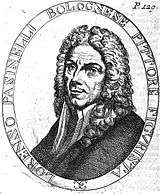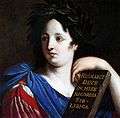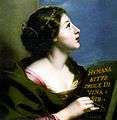Lorenzo Pasinelli

Lorenzo Pasinelli (September 4, 1629 – March 4, 1700) was an Italian painter active mainly in Bologna during the late Baroque period.
He was born in Bologna, and initially trained in the studio of Simone Cantarini. He then pursued studies in Rome. Despite that training, his works have an air of Mannerism. In an overview of two major Bolognese painters circa 1700, one author describes that Pasinelli:[1]
Lorenzo liked the design of Raphael joined with the charm of Paolo Veronese; while Carlo (Cignani) liked the grace of Correggio united to the erudition of Annibale (Carracci) ... while Pisanelli did not attain a fullness of correct design, which (Veronese) had advanced ... no one will fail to recognize in Pisanelli large picturesque fire and great new ideas, but sometimes is a tad forced in his movements, and using new and bizarre clothes.
He collaborated after 1648 with Flaminio Torre. He is known to have painted a Miracle of St. Anthony for the church of San Francesco (now found in San Petronio) He painted for the local Senatore Francesco Ghisilieri a Love disarmed by the nymphs of Diana, now found in the Pinacoteca BPER of Modena. Attributed to Pasinelli, in the same collection is an atypical, almost genre-like allegory of a Young Girl with an Open Cage. He painted a Holy Family and a Resurrection of the dead for the church of San Francesco in Bologna. He also painted Christ's Entry into Jerusalem and a Christ's return from Purgatory for the former Certosa of Bologna.[2]
His pupils included Gian Antonio Burrini, Gioseffo dal Sole, Giovanni Pietro Zanotti, Giuseppe Maria Mazza, Antonio Lorenzini, and Donato Creti.

Libyan Sibyl 
Erythraean Sibyl 
Sibyl 
St Cecilia (1665) 
Roman Charity (1670) Sophonisba (1649) 
Sibyl inspired by Putto (Budrioli Family Sibyl) 
Lute Player Mary Magdalen 
Diana and Nymphs 
Christ enters Jerusalem 
Resurrected Christ and Fathers of Church visit his Mother Mary 
Adoration by Shepherds St Anthony of Padua performs a Resurrection (San Petronio, Bologna) 
Divorce of Julia, wife of Pompey (1672-1676) 
Hercules at Crossroads (1690)
External links
![]() Media related to Lorenzo Pasinelli at Wikimedia Commons
Media related to Lorenzo Pasinelli at Wikimedia Commons
References
- Wittkower, Rudolf (1993). Pelican History of Art, ed. Art and Architecture Italy, 1600-1750. 1980. Penguin Books. p. 343.
- Artnet biography from Grove encyclopedia of Art.
- Farquhar, Maria (1855). Ralph Nicholson Wornum, ed. Biographical catalogue of the principal Italian painters. Woodfall & Kinder, Angel Court, Skinner Street, London; Digitized by Googlebooks from Oxford University copy on Jun 27, 2006. pp. 120–121.
- Artcyclopedia entry
Notes
- ↑ Il costume antico e modern, Volume 9, Issue 3, chapter on Painting, By Giulio Ferrario, Publisher Alessandro Fontana 1833, page 224.
- ↑ Lanzi, Luigi (1847). History of Painting in Italy. From the Period of the Revival of the Fine Arts to the End of the Eighteenth Century (Volume III). London: Henry G. Bohn. pp. 144–145.